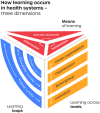A conceptual learning analysis of paired after action and intra action reviews for health emergencies
- PMID: 39444507
- PMCID: PMC11493552
- DOI: 10.1002/lrh2.10447
A conceptual learning analysis of paired after action and intra action reviews for health emergencies
Abstract
Background: Processes of self-reflection and the learning they allow are crucial before, during, and after acute emergencies, including infectious disease outbreaks. Tools-such as Action Reviews-offer World Health Organization (WHO) member states a platform to enhance learning. We sought to better understand the value of these tools and how they may be further refined and better used.
Methods: We searched the publicly available WHO Strategic Partnership for Health Security website for paired reports of Action Reviews, that is, reports with a comparable follow-up report. We complemented the paired action reviews, with a literature search, including the gray literature. The paired action reviews were analyzed using the "Learning Health Systems" framework.
Results: We identified three paired action reviews: Lassa Fever After Action Reviews (AARs) in Nigeria (2017 and 2018), COVID-19 Intra-Action Reviews (IARs) in Botswana (2020 and 2021), and COVID-19 IARs in South Sudan (2020 and 2021). Action Reviews allowed for surfacing relevant knowledge and, by engaging the right (in different contexts) actors, asking "are we doing things right?" (single loop learning) was evident in all the reports. Single loop learning is often embedded within examples of double loop learning ("are we doing the right things?"), providing a more transformative basis for policy change. Triple loop learning ("are we learning right"?) was evident in AARs, and less in IARs. The range of participants involved, the level of concentrated focus on specific issues, the duration available for follow through, and the pressures on the health system to respond influenced the type (i.e., loop) and the effectiveness of learning.
Conclusion: Action Reviews, by design, surface knowledge. With favorable contextual conditions, this knowledge can then be applied and lead to corrective and innovative actions to improve health system performance, and in exceptional cases, continuous learning.
Keywords: AAR; COVID‐19; IAR; action reviews; emergency; health system; learning.
© 2024 The Author(s). Learning Health Systems published by Wiley Periodicals LLC on behalf of University of Michigan.
Conflict of interest statement
This work was carried out as part of Elliot Brennan's PhD research at the University of Sydney. It does not represent the views of any past affiliation with the WHO or other organizations. Elliot Brennan is a PhD candidate at the University of Sydney. He has worked as a consultant for the World Health Organization's Country Simulation and Review Unit in Geneva and the WHO Western Pacific Regional Office Strategic Dialogues Unit. He has designed and facilitated COVID‐19 after action reviews, simulation exercises, and other strategic dialogs with the aim of system learning during and after crises. Seye Abimbola is a health systems researcher from Nigeria. He is currently based at the University of Sydney in Australia, where his teaching and research focus on knowledge practices in global health, health system governance, and the adoption and scale up of health system innovations. Dr Abimbola was awarded the 2020–2022 Prince Claus Chair in Equity and Development at Utrecht University in the Netherlands for his work on justice in global health research. He is the editor‐in‐chief of BMJ Global Health.
Figures
References
-
- Sheikh K, Abimbola S. Learning Health Systems: Pathways to Progress. Flagship Report of the Alliance for Health Policy and Systems Research. 2021. https://ahpsr.who.int/publications/i/item/learning-health-systems-pathwa....
-
- Sheikh K, Agyepong I, Jhalani M, et al. Learning health systems: an empowering agenda for low‐income and middle‐income countries. Lancet. 2020;395(10223):476‐477. - PubMed
LinkOut - more resources
Full Text Sources
Miscellaneous




